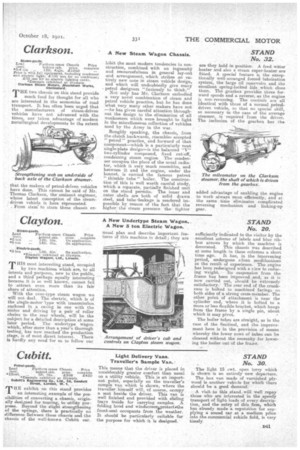Clayton.
Page 37

If you've noticed an error in this article please click here to report it so we can fix it.
A New Undertype Steam. Wagon, , A New 5. ton Electric Wagon.
STAND No. 20.
THIS most interesting stand, occupied by two machines Which are, -to all intents and purposes, new to the public, and a third perhaps equally interesting because it is so well known, cannot fail to attract even more than its fair share of attention.
With the over-type steam wagon we will not deal. The electric, which is of the single-motor "type with transmission enclosed in a casing in one with the motor and driving by a pair, of roller chains to the rear wheels, will he the subject, for a detailed description at some later period. The undertype wagon which, after more than a year's thorough testing has now reached the production stage, is of most direct interest. There is hardly any need for us to follow our
usual plan and describe important features of this machine in detail; they are sufficiently indicated to the visitor-by the excellent scheme of labels and blue ribbon arrows by which the machine is decorated. This chassis was described at some length in these columns a short time ago. It has, in the intervening period, undergone silent modifications as the result of experience. The engine has been redesigned with a view to reduc ing weight. Its suspension from the frame has been improved and, as it is now carried out, should be extremely satisfactory. The rear end of the crankcase is bolted to machined facings on both sides of a strong cross-member. The other point of attachment is near the cylinder end, where it is bolted to a more or less flexible bracket, which hangs from the frame by a single pin, about which it may pivot.
The boiler tubes are straight, as in the case of the Sentinel, and the. improvement here is in the provision of means whereby the lower rows of tubes can be cleaned without the necessity for lowering the boiler out of the fraree.
































































